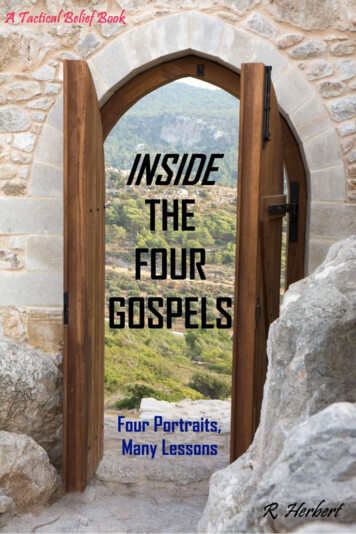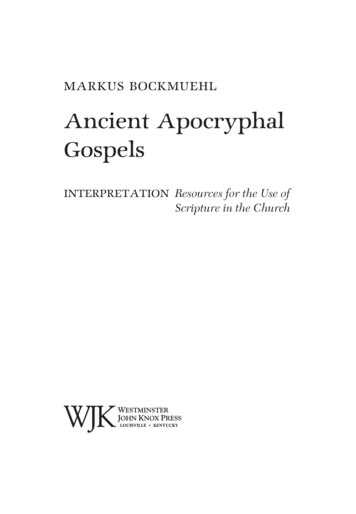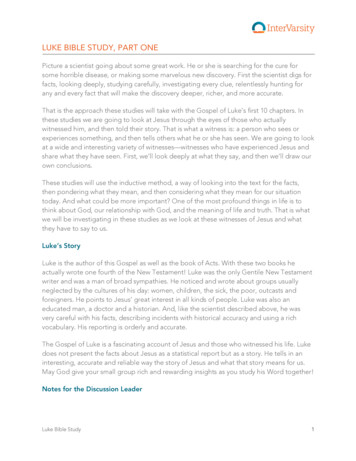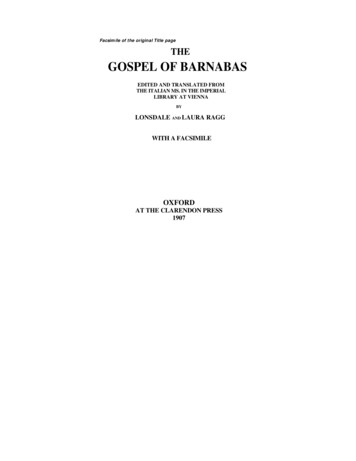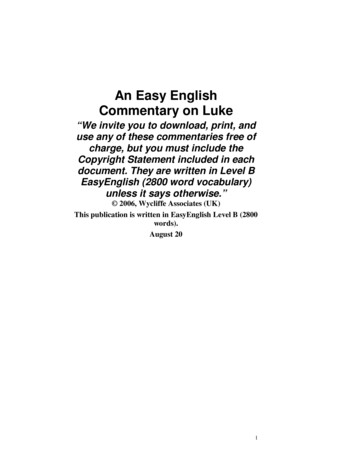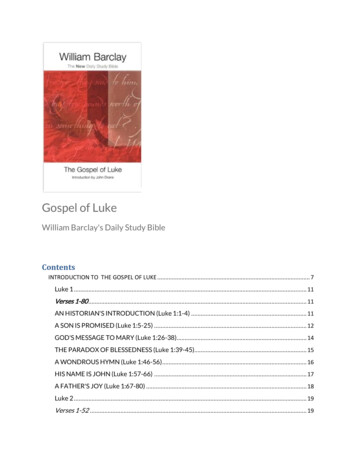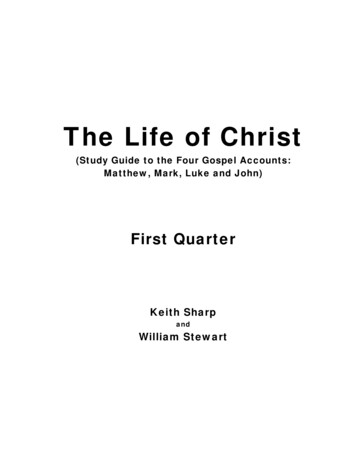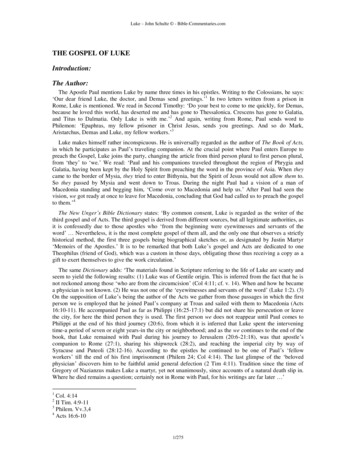
Transcription
Luke – John Schultz - Bible-Commentaries.comTHE GOSPEL OF LUKEIntroduction:The Author:The Apostle Paul mentions Luke by name three times in his epistles. Writing to the Colossians, he says:‘Our dear friend Luke, the doctor, and Demas send greetings.’1 In two letters written from a prison inRome, Luke is mentioned. We read in Second Timothy: ‘Do your best to come to me quickly, for Demas,because he loved this world, has deserted me and has gone to Thessalonica. Crescens has gone to Galatia,and Titus to Dalmatia. Only Luke is with me.’2 And again, writing from Rome, Paul sends word toPhilemon: ‘Epaphras, my fellow prisoner in Christ Jesus, sends you greetings. And so do Mark,Aristarchus, Demas and Luke, my fellow workers.’3Luke makes himself rather inconspicuous. He is universally regarded as the author of The Book of Acts,in which he participates as Paul’s traveling companion. At the crucial point where Paul enters Europe topreach the Gospel, Luke joins the party, changing the article from third person plural to first person plural,from ‘they’ to ‘we.’ We read: ‘Paul and his companions traveled throughout the region of Phrygia andGalatia, having been kept by the Holy Spirit from preaching the word in the province of Asia. When theycame to the border of Mysia, they tried to enter Bithynia, but the Spirit of Jesus would not allow them to.So they passed by Mysia and went down to Troas. During the night Paul had a vision of a man ofMacedonia standing and begging him, ‘Come over to Macedonia and help us.’ After Paul had seen thevision, we got ready at once to leave for Macedonia, concluding that God had called us to preach the gospelto them.’4The New Unger’s Bible Dictionary states: ‘By common consent, Luke is regarded as the writer of thethird gospel and of Acts. The third gospel is derived from different sources, but all legitimate authorities, asit is confessedly due to those apostles who ‘from the beginning were eyewitnesses and servants of theword’ Nevertheless, it is the most complete gospel of them all, and the only one that observes a strictlyhistorical method, the first three gospels being biographical sketches or, as designated by Justin Martyr‘Memoirs of the Apostles.’ It is to be remarked that both Luke’s gospel and Acts are dedicated to oneTheophilus (friend of God), which was a custom in those days, obligating those thus receiving a copy as agift to exert themselves to give the work circulation.’The same Dictionary adds: ‘The materials found in Scripture referring to the life of Luke are scanty andseem to yield the following results: (1) Luke was of Gentile origin. This is inferred from the fact that he isnot reckoned among those ‘who are from the circumcision’ (Col 4:11; cf. v. 14). When and how he becamea physician is not known. (2) He was not one of the ‘eyewitnesses and servants of the word’ (Luke 1:2). (3)On the supposition of Luke’s being the author of the Acts we gather from those passages in which the firstperson we is employed that he joined Paul’s company at Troas and sailed with them to Macedonia (Acts16:10-11). He accompanied Paul as far as Philippi (16:25-17:1) but did not share his persecution or leavethe city, for here the third person they is used. The first person we does not reappear until Paul comes toPhilippi at the end of his third journey (20:6), from which it is inferred that Luke spent the interveningtime-a period of seven or eight years-in the city or neighborhood; and as the we continues to the end of thebook, that Luke remained with Paul during his journey to Jerusalem (20:6-21:18), was that apostle’scompanion to Rome (27:1), sharing his shipwreck (28:2), and reaching the imperial city by way ofSyracuse and Puteoli (28:12-16). According to the epistles he continued to be one of Paul’s ‘fellowworkers’ till the end of his first imprisonment (Philem 24; Col 4:14). The last glimpse of the ‘belovedphysician’ discovers him to be faithful amid general defection (2 Tim 4:11). Tradition since the time ofGregory of Nazianzus makes Luke a martyr, yet not unanimously, since accounts of a natural death slip in.Where he died remains a question; certainly not in Rome with Paul, for his writings are far later ’1Col. 4:14II Tim. 4:9-113Philem. Vv.3,44Acts 16:6-1021/275
Luke – John Schultz - Bible-Commentaries.comAbout the Gospel of Luke and Acts, The Pulpit Commentary observes: ‘This Third Gospel was mostcarefully composed, with the view of satisfying the requirements of a thoughtful, cultured man, such as wasprobably that ‘most excellent Theophilus’ to whom the Gospel was addressed.First, it contained, with its sequel the Acts, not a few historical notices, such as the census of Quirinius,under the decree of Augustus ( Acts 2:1-3); the contemporary Roman and Jewish rulers in the fifteenthyear of Tiberius Caesar ( Acts 3:1, 2); Pilate’s and Herod’s jurisdictions (chapter 23:1, 12); withallusions by name to public persons, such as Cornelius, centurion of the Italian band ( Acts 10:1); Herod( Acts 12:1, etc.; 13:1); Sergius Paulus ( Acts 13:7); the Emperor Claudius’s decree ( Acts 18:2);Gallic the deputy of Achaia ( Acts 18:12-16); Claudius Lysias, Felix the Roman governor ( Acts23:26); Porcius Festus ( Acts 24:27); King Agrippa and Bernice (Acts 25); the appeal to Caesar ( Acts26:32).Secondly, it embodied in its narrative that beautiful and interesting account of the nativity and the eventswhich preceded it and immediately succeeded it, with a few notices of the boyhood of the Lord. Thesedetails were evidently procured from information communicated to St. Luke (or St. Paul) by eyewitnesses, many of the details probably by the virgin-mother herself. These two first chapters would answermany a question which would naturally suggest itself to reverent inquirers who had listened to the simplegospel message as first delivered, and had enrolled themselves among the followers of Jesus Christ.Thirdly, the picture of the gradual development of the Church of Jesus Christ is drawn with extraordinaryskill and care by St. Luke — its development from Bethlehem and Nazareth to Jerusalem and Rome. Onthe morning of the nativity, in the opening chapters of St. Luke, the Church is confined to Joseph, Mary,and the holy Babe. To these, just the few shepherds of Bethlehem are added. The close of the Acts showsus the foundation of the Church at Rome; but Rome was but a branch, an offshoot, of the great Churches ofAntioch and Jerusalem. St. Luke traces the various stages in this development — from Bethlehem toNazareth, from Nazareth to Capernaum, from Capernaum to the Galilaean and Peraean villages, then toJerusalem. The Acts takes up the wondrous story, and shows how the Church, advanced from Jerusalem tothe Syrian Antioch, from Antioch to the cities of Asia Minor, from great Asian centers like Ephesus acrossthe seas to the old world-renowned cities of Greece, and then from Greece to Italy, and the story closeswith the beginning of the Church at Rome. Nor does St. Luke alone depict with his great skill thegeographical development of the Church of Jesus Christ. He describes, too, how the work of the DivineMaster and his chosen instruments developed. First, we have the story of the birth and growth of thepioneer, John the Baptist; then the birth and childhood of Jesus himself. He paints the beginning of hisorganized Church, when he summons the twelve out of the number of believers who gathered round himsoon after he began his public ministry among men. The wants of the growing organization soon called formore workers. In the Third Gospel the solemn summons of the seventy is related. For a moment theadvancing work seems arrested by a fatal blow, and the death of the Master on the cross puts, as it seems, afinal stop to the new Church and its work; but the Resurrection, which St. Luke describes as quicklyfollowing, gives a new and irresistible impulse to the Church and the Church’s work among men. The samemen are at work, and the same Master is guiding their labors. But the homeless Master is no longer guidingthem as they walked together among the fields of Galilee and the streets of Jerusalem, but from his glorythrone in heaven; and the men, the same men, are quite changed: it is as though they had drunk of thewaters of another and stronger life.Luke describes in the Acts, the sequel to his Gospel, the rapid progress and the swift though orderlydevelopment of the now great and numerous Church. Deacons are chosen to assist the apostles; then weread of prophets and teachers and elders, of the foundation-stories of a great and powerful organization.’Date and Place of writing:There is no certainty about the date at which this Gospel could be written. Most Bible scholars place isafter the Gospel of Mark, which may have been written as early as 50 AD. It is obvious that Luke wrote hisGospel before writing Acts. And Acts must have been written before the death of the Apostle Paul, whichoccurred around 67 AD.The New Unger’s Bible Dictionary observes about the date: ‘Since the book was written before the Acts,which is to be dated c. A.D. 61, it was likely written while Paul was at Caesarea. Since internal evidencethat Luke wrote both the gospel and the book of Acts (and he divulges the fact that the gospel was written2/275
Luke – John Schultz - Bible-Commentaries.comfirst, Acts 1:1), it must be concluded that the gospel was penned prior to A.D. 61. Luke was in Caesareawhere Paul was in prison (Acts 27:1). This circumstance would furnish him opportunity for the research hementions with such fine literary style and classical flourish in Luke 1:1-4.’ Whether this means that Lukewrote, while in Caesarea, cannot be ascertained.Barnes’ Notes observes the following about the place and time of the writing of this Gospel: ‘It is notknown where it was written. Jerome says it was composed in Achaia. There seems to be some probabilitythat it was written to persons that were well acquainted with Jewish manners, as the author does not stop toexplain the peculiar customs of the Jews, as some of the other evangelists have done. Respecting the timewhen it was written nothing very definite is known. All that can with certainty be ascertained is that it waswritten before the death of Paul (65 A.D.), for it was written before the Acts Acts 1:1, and that book onlybrings down the life of Paul to his imprisonment at Rome, and previous to his going into Spain.’About Luke’s identity, Barnes’ Notes writes: ‘It has been made a matter of inquiry whether Luke was aGentile or a Jew. On this subject there is no positive testimony. Jerome and others of the fathers say that hewas a Syrian, and born at Antioch. The most probable opinion seems to be that he was a proselyte to theJewish religion, though descended from Gentile parents. For this opinion two reasons may be assigned ofsome weight. First, he was intimately acquainted, as appears by the Gospel and the Acts, with the Jewishrites, customs, opinions, and prejudices; and he wrote in their ‘dialect,’ that is, with much of the Hebrewphraseology, in a style similar to the other evangelists, from which it appears that he was accustomed to theJewish religion, and was, therefore, probably a proselyte. Yet the ‘preface’ to his Gospel, as critics haveremarked, is pure classic Greek, unlike the Greek that was used by native Jews; from which it seems notimprobable that he was by birth and education a Gentile. Second, In Acts 21:27, it is said that the AsiaticJews excited the multitude against Paul because he had introduced ‘Gentiles’ into the temple, thus defilingit. In Acts 21:28 it is said that the Gentile to whom they had reference was ‘Trophimus,’ an Ephesian. Yet‘Luke’ was also at that time with Paul. If he had been regarded as ‘a Gentile’ it is probable that they wouldhave made complaint respecting ‘him’ as well as ‘Trophimus;’ from which it is supposed that he was aJewish proselyte.’Characteristics of Luke’s Gospel:The Gospel of Luke has been called ‘the most beautiful book ever written.’ The style is charming andcultured and the way the stories are told is perfect.In other studies we have put the question what difference it would make if we cut out of the Bible thebook that is the subject of our investigation. How much of the Bible message would we loose if Luke werenot one the Gospels? One example provides sufficient proof: The Christmas Story. Without Luke ChapterTwo there would be no Christmas, no angels, no shepherds, no baby in a manger, etc.But how did Luke do it? He was not there when Jesus was born in Bethlehem; he was maybe not evenborn at that time. But Mary, the mother of Jesus was and she was probably on of the first persons to beinterviewed by Luke.We assume that Luke received his first instructions about the Gospel of Jesus Christ from or via theApostle Paul, whose travel companion he eventually became. Luke may even have been one of Paul’sconverts. But even Paul had never known Jesus personally before his encounter with the risen and glorifiedLord on the way to Damascus. Whether Paul had ever seen or heard Jesus before the crucifixion isdoubtful. Although Paul could have given Luke a wealth of information about Christ’s message, he couldnot provide and biographical details about the Savior or give details about certain highlights of His life andministry.The assumption is that those details were still well-known and passed on orally. From The PictorialBible Dictionary, we copy the following: ‘A clue to the transition from oral preaching to written record isprovided by explanatory statements in the Gospels of Luke and John. In the introduction to his Gospel,Luke asserts that he was undertaking to confirm by manuscript that his friend Theophilus had alreadylearned by word of mouth (Luke 1:1-4). He spoke of facts which were taken for granted among believers,and indicated that there had already been numerous attempts to arrange them in orderly narratives. Lukeaffirmed on the contrary that he had derived his facts from those who ‘from the beginning were eyewitnesses and ministers of the word’ (1:2). Not only had his informants shared in the events of which they3/275
Luke – John Schultz - Bible-Commentaries.comspoke, but also they had been so affected that they became propagandists of the new faith. Luke had been acontemporary of these witnesses, and had investigated personally of the truth of their claims that he mightproduce an orderly and accurate record of the work of Christ.’4/275
Luke – John Schultz - Bible-Commentaries.comOutline of the Book5THE GOSPEL OF LUKE . 1Introduction: . 1The Author: . 1Date and Place of writing:. 2Characteristics of Luke’s Gospel: . 3Outline of the Book . 5PREFACE 1:1-4. 131. THE INFANCEY NARRATIVES 1:5 – 2:52 . 14A. The birth of John foretold 1:5-25 . 14B. The birth of Jesus foretold 1:26-38. 18C. Mary’s visit to Elizabeth 1:39-45 . 21D. The song of Mary 1:46-56 . 22E. The birth and naming of John1:57-66. 25F. The song of Zechariah 1:67-80 . 26G. The birth of Jesus 2:1-7 . 30H. The angels and the shepherds 2:8-20 . 32I. The baby Jesus 2:21-40 . 371.The circumcision 2:21 . 372.The presentation in the temple 2:22-24 . 373.The song of Simeon 2:25-32 . 384.Simeon’s prophecy 2:33-35 . 395.Anna’s thanksgiving 2:36-38. 406.The return to Nazareth 2:39-40. 41J. The boy Jesus in the temple2:41-52 . 412. The ministry of John the Baptist 3:1-20 . 453. The beginning of Jesus’ ministry 3:21-4:13 . 51A. Jesus’ baptismB. Jesus’ genealogy3:21-22 . 513:23-38. 52C. Jesus’ temptations 4:1-13 . 535From Tyndale New Testament Commentaries Luke, by Leon Morris.5/275
Luke – John Schultz - Bible-Commentaries.com4.Jesus in Galilee 4:14-30 . 58A. The sermon at Nazareth 4:14-30 . 58B.1.Jesus healing 4:31-41. 61The man with an unclean spirit 4:31-37 . 612. Peter’s mother-in-law 4:38-39 . 633. Many healings 4:40-41 . 63C. A preaching tour 4:42-44 . 64D. Jesus’ miracles 5:1-26 . 641. The miraculous catch of fish 5:1-11 . 642. Healing a leper5:12-16 . 663. Healing a paralytic 5:17-26 . 67E. The calling of Levi 5:27-32 . 70F. Fasting5:33-39 . 72G. The right use of the sabbath 6:1-11 . 741. Lord of the sabbath 6:1-5 . 742. Healing the withered hand6:6-11. 75H. Choosing the Twelve 6:12-16 . 76I. The sermon on the plain 6:17-49 . 781. The multitude6:17-19 . 792. The beatitudes 6:20-23 . 793. The woes4. Love6:24-26 . 806:27-36 . 805. Judging other people 6:37-42. 816. The tree and the fruit 6:43-45 . 837. Foundations 6:46-49. 83J. Healing the centurion’s slave 7:1-10 . 84K. The widow of Nain’s son 7:11-17 . 86L. John the Baptist’s questions (7:18-35). 881. The questions asked and answered 7:18-23 . 882. The greatness of John7:24-30 . 903. The reaction of the hearers 7:31-35. 926/275
Luke – John Schultz - Bible-Commentaries.comM. The anointing of Jesus by a sinful woman 7:36-50 . 93N. Women who helped Jesus 8:1-3 . 96O. The parable of the sower 8:4-15 . 97P. The lamp and the cover 8:16-18 . 101Q. Jesus’ mother and brothers 8:19-21. 103R. The stilling of the storm 8:22-25 . 104S. The Gerasene demoniac8:26-39. 1061. The exorcism 8:26-33 . 106T. The daughter of Jairus 8:40-56 . 1081. The request for healing 8:40-42a . 1082. The woman with the hemorrhage8:42b-48 . 1093. Jairus’ daughter raised from the dead 8:49-56 . 111U. The mission of the twelve 9:1-6 . 113V. Herod the tetrarch 9:7-9 . 114W. The feeding of the five thousand 9:10-17. 115X. Discipleship 9:18-27. 1171. Peter’s confession 9:18-20 . 1172. A prophecy of the passion9:21-22. 1193. Taking up the cross 9:23-27. 119Y. The transfiguration 9:28-36 . 121Z. Jesus and the disciples 9:37-50. 1241. The demon-possessed boy 9:37-43a. 1242. Another prophecy of the passion 9:43b-45 . 1263. The disciples’ pride 9:46-48. 1264. The strange exorcist 9:49-50 . 1275. From Galilee to Jerusalem 9:51-19:44. 128AA. More lessons in discipleship 9:51-62 . 1281. Rejection by the Samaritans9:51-56 . 1282. Whole-heartedness 9:57-62 . 129BB. The mission of the seventy 10:1-24 . 1311. The mission and the message 10:1-12 . 1317/275
Luke – John Schultz - Bible-Commentaries.com2. The doom of the Galilean cities 10:13-16 . 1323. The return of the seventy10:17-20 . 1334. Jesus’ joy 10:21-24 . 135CC. The good Samaritan 10:25-37 . 136DD. Martha and Mary 10:38-42 . 139EE. Prayer . 1401. The Lord’s prayer 11:1-4 . 1402. The friend at midnight 11:5-8. 1433. Asking and giving 11:9-13 . 144FF. Jesus and the evil spirits11:14-26 . 1451. The Beelzebul controversy 11:14-23 . 1452. The return of the evil spirit 11:24-26 . 147GG. Jesus teaches the people 11:27 – 12:59 . 1481. True blessedness 11:27-28 . 1482. The sign of Jonah 11:29-32 . 1493. The light that is in you 11:33-36 . 1504. True cleansing11:37-41 . 1515. Woe to the Pharisees 11:42-44 . 1526. Woe to the lawyers 11:45-54 . 1537. The leaven of the Pharisees 12:1-3 . 1548. Be ready for judgment 12:4-12 . 1569. The rich fool 12:13-21 . 15810. Seek the kingdom 12:22-34 . 15911. The coming of the Son of man 12:35-40 . 16212. The responsibility of the servant 12:41-48. 16313. Fire on the earth 12:49-53 . 16514. The signs of the time 12:54-59 . 166HH. Repentance 13:1-9 . 1671. People who perished 13:1-5. 1672. The man seeking fruit 13:6-9. 169II. Healing a bent woman 13:10-17 . 1698/275
Luke – John Schultz - Bible-Commentaries.comJJ. The kingdom of God13:18-30 . 1711. The mustard seed 13:18-19. 1712. The Yeast 13:20-21 . 1723. Who are in the kingdom?13:22-30 . 172KK. Prophets perish in Jerusalem 13:31-35 . 1741. That fox Herod13:31-33. 1742. Lament over JerusalemLL. Dinner with a Pharisee13:34-35 . 17514:1-24 . 1761. Healing of a man with dropsy 14:1-6 . 1762. Invitation to a banquet 14:7-14 .
The New Unger’s Bible Dictionary states: ‘By common consent, Luke is regarded as the writer of the third gospel and of Acts. The third gospel is derived from different sources, but all legitimate authorities, as it is confessedly due to those apostles who
